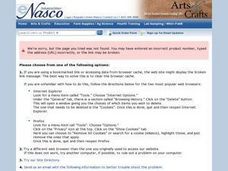Curated OER
Egyptian Museum
Students explore ancient Egypt. Using a specified Internet site, students locate and describe the physical setting that supported early civilizations in Egypt. They explain the relationship between polytheism and the social and...
Curated OER
Draw Like an Egyptian
Second graders explore Egyptian life and art and examine Egyptian figures and translate them to their own artwork. Students use objects other than paint brushes to paint. Students practice using watercolors and practice figure proportions.
Curated OER
Journey to the Afterlife
Students work together to design an Egyptian funerary barge. They discover the importance of the afterlife to Egyptians. They create their boat and share their design with the class. They compare and contrast the technology of Ancient...
Curated OER
Nasco Color Sculpt Mask Making
Learners study the various masks made in African, Japanese, and Ancient Egyptian cultures and discuss the funtion of these masks in each society. They create a mask from one of these cultures using a molding technique.
Curated OER
Egypt: Ancient Culture
Students access a variety of Internet resources regarding Ancient Egyptian culture, society, and geography. They view photos and timelines, take a virtual tour of the Nile, play interactive games,and watch video clips about modern Egypt.
Curated OER
The Day of Ahmed's Secret
Students create a postcard showing something they have learned about Cairo, Egypt.
Curated OER
Who Built the Pyramids?
Students examine the two theories on how the pyramids at Giza were built. They watch a video on pyramids, take notes, and write a five-paragraph essay on how they think the pyramids were constructed.
Curated OER
Mummies Made in Egypt
Students use maps to locate information on Egypt, then create their own maps to display knowledge gained from the lesson and Web sites. They recognize, create, and describe the pyramid's geometric shape in three-dimensional forms.
Curated OER
The Day of Ahmed's Secret
Students create a postcard showing and telling something they have learned about Cairo, Egypt.
Curated OER
The Science Of Mummies
Students explore how new advancements in technology can lead to advancements in scientific knowledge, and specifically how new technologies are advancing the study of mummies.
Curated OER
Body Building
Pupils determine whether ancient Egyptian drawing was proportional and in perspective by comparing ancient Egyptian drawings, a mummy's x-ray, and contemporary photographs of people.
Curated OER
Measuring a Mummy Case
Learners practice how to calculate volume using mummy cases. They measure using ancient Egyptian, U.S., and metric systems. They explore how to convert measurements into different systems, and discuss ratios.
Curated OER
Portrait of a Ruler
Students create a full-length portrait of the Emperor Hadrian that conveys his role through attributes and explain how this bust of Hadrian conveys a story about life as an emperor in ancient Rome.
Curated OER
Form, Story, and Function: Then and Now
Young scholars compare the function and decoration of everyday objects from ancient Greece and today's world. They complete a chart imbedded in this lesson that enables them to compare today's objects to objects of the past.
Curated OER
Explaining a Legend
Students explain the place of the legend of Herakles in ancient Greek life and compare ancient and modern legends in an essay.
Curated OER
Daily Life in Ancient Egypt
Students explain how artwork can inform about a culture and its traditions. They pretend to be archaeologists who have just opened a tomb. They interpret the past based on what they discover.

















